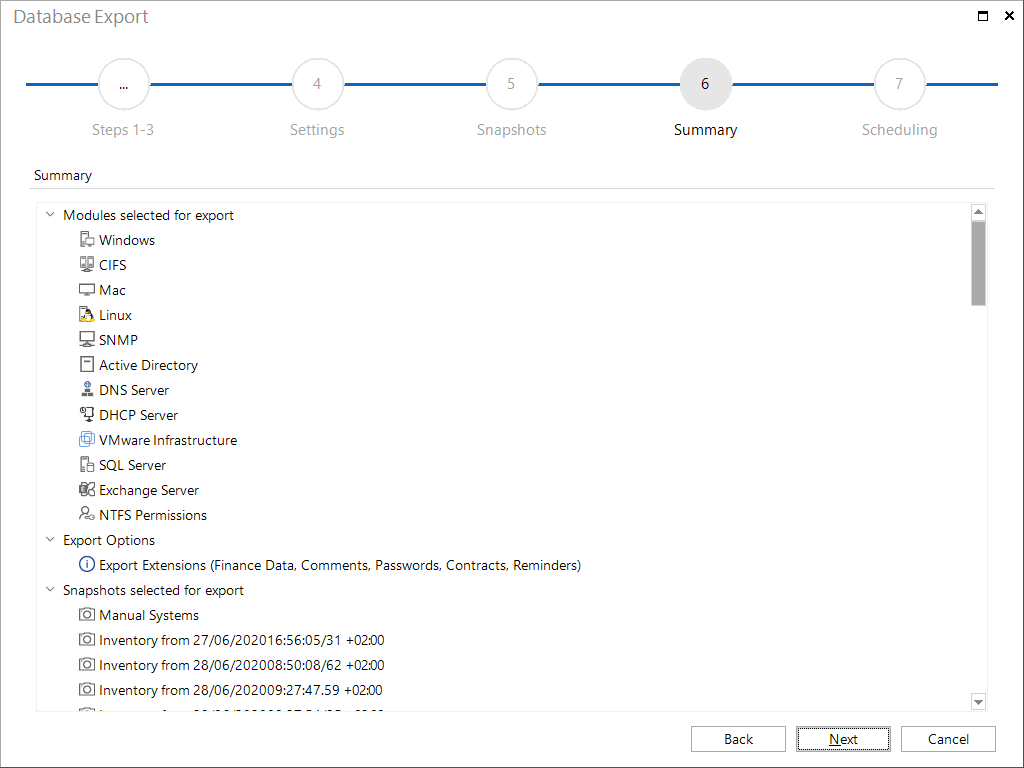Database Export
4 minute read
With Docusnap, you can import data from another database.
The dialog used to perform the data export can be opened from the All Jobs area by clicking the DB Export button.

In the first step, select the target database to which the data is to be exported. For this purpose, you can select an SQL or local database. These two database systems are fully compatible with each other. This means that data exported from an SQL database can be imported into a local database, and vice versa.

In the next step, specify the export settings. The left column lists the companies and domains that are found in the database to be exported. The companies existing in the target database are displayed on the right. You can export an entire company or an individual domain to the target database. As you go, you can either export the domain data to an existing company, or you can re-create the original company from the source database.
For the target database, you can decide to re-create the company from the source database in the target database or to integrate the data into an existing company. If you select the Integrate Company from Source Database option, a new company will be created. If a company with the same name already exists, a second company with this name will be created.
If you select the Integrate in existing Company option, the data will be integrated into the selected company.
When assigning companies automatically, Docusnap does not compare by company name, but rather uses an internal GUID (Globally Unique IDentifier). In some cases, two companies with the same name might exist after the import.
The best way to avoid this situation is to explicitly select a company in the target database.
During the export, Docusnap will check whether a specific snapshot was exported before. If this is the case, the corresponding snapshot will be excluded from the export. Furthermore, Docusnap will check for each system whether the number of allowed archives will be exceeded. The oldest snapshots will be deleted, if necessary.

If you want to exclude certain source database modules from the export, clear the checkmark for those which are not to be exported. If, for example, only the Windows checkbox is enabled, nothing but the workstation and server data will be exported. In addition, only snapshots containing data for the selected modules will be displayed in the next step.

To export existing [additional information]( “additional information”) associated with source database objects, enable the Export Additional Information checkbox in the Advanced group.
If you enable the Overwrite existing Data checkbox, the properties of static objects from the source database will overwrite those existing in the target database. Thus, for example, the street address of a company that has been selected in the source database would overwrite the street address in the target database. Please note that this feature will only affect static objects and not the snapshots.
If you wish to export the diagrams created in your database as well, enable the Export Diagrams checkbox.
What is more, you can export any passwords that have been created. For this purpose, an encryption file is required. Click the  icon and select the appropriate file. Its name will then be displayed in the Export Encryption File field.
icon and select the appropriate file. Its name will then be displayed in the Export Encryption File field.

Here, a list of snapshots from the selected source database is displayed. To find snapshots more quickly, you can either name them when doing the inventory scan, or you can assign a name to them in the Manage Snapshots dialog. To the right of the snapshot list, a filter is available for easier selection of individual snapshots.

Finally, a summary page provides an overview of the modules and snapshots to be imported. If you want to change any of the data import settings, click the Back button. To start the import, click the Start button.

Through Scheduling, you can specify that the Data Export routine will start automatically at a later point in time. In the Scheduling step, you can define whether the export will be a one-time or a recurring event. Please note, however, that this feature can only be used if the Docusnap Server is installed on a system in the network. If the data export is scheduled, the schedule is saved by clicking on the Finish button and the wizard closes. If the checkbox Schedule Database Export was not activated, click the Start button to start the export process.
During the database export, its status will be displayed. To abort the export process, click the Cancel button. The data that has been exported up to that moment will be retained in the target database. Finally, the Report page will be displayed.